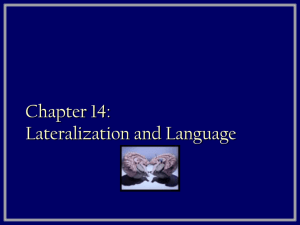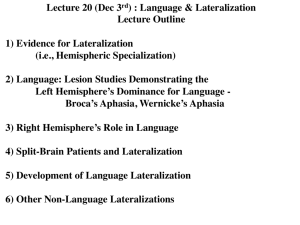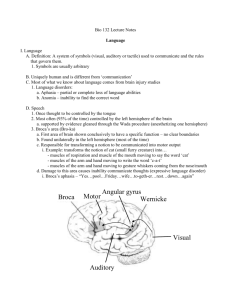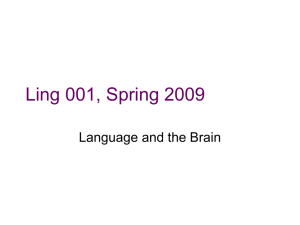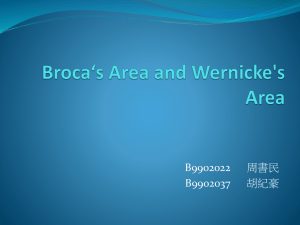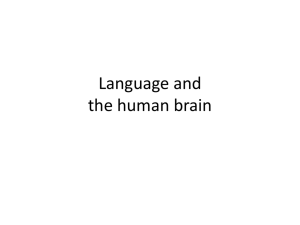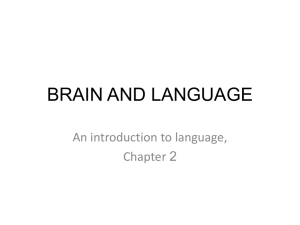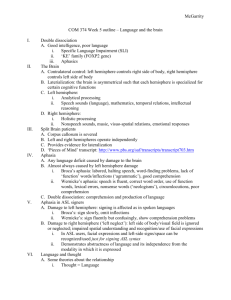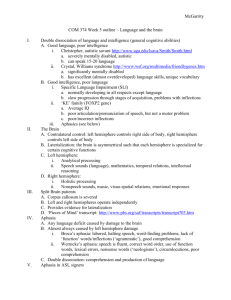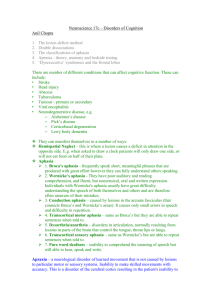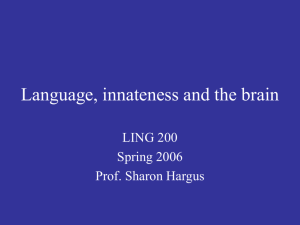BRAIN LATERALIZATION
advertisement
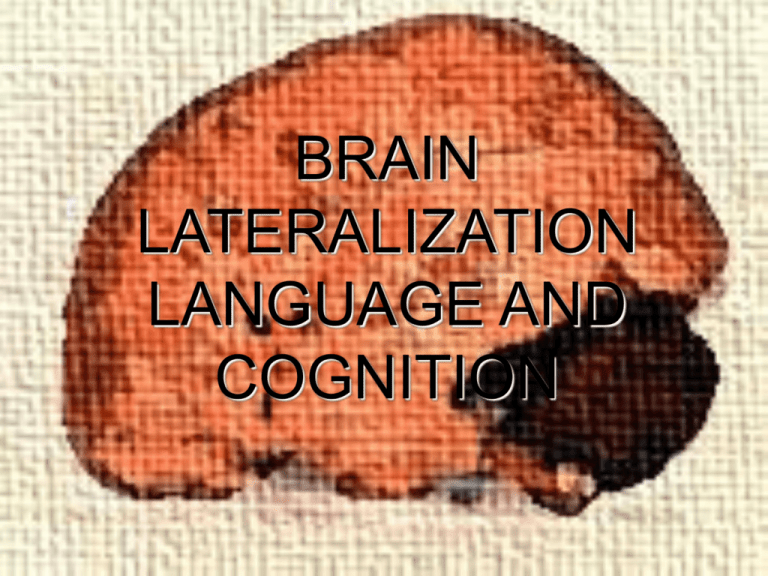
BRAIN LATERALIZATION LANGUAGE AND COGNITION CEREBRAL LATERALIZATION Significant Events in History • Marc Dax (1836) Dax was the first to report left hemisphere involvement in speech disorders caused by brain damage. • Paul Broca (1860’s) Unaware of Dax’s work, Broca made key discoveries regarding left hemisphere involvement in aphasia. • Broca’s area, Broca’s aphasia • Hugo-Karl Liepmann (1900’s) Apraxia is almost always caused by left hemisphere damage. CEREBRAL LATERALIZATION Assessments of Lateralization • Sodium Amytal Test • Dichotic Listening Test • Functional Brain Imaging CEREBRAL LATERALIZATION Speech lateralization and handedness • The left hemisphere is dominant for speech in majority, both right- and left-handed, although greater variability among left-handed individuals. Neurological studies of aphasics (Russell & Esper, 1961). • Right handed aphasics: 60% left, 2% right hemisphere damage • Left handed aphasics: 30% left, 24% right hemisphere damage Results of Sodium amytal tests (Milner, 1974). Left-hemisphere dominance for speech in: • 92% of right-handed individuals • 69% of left-handed or ambidextrous individuals • 30% of left-handed or ambidextrous individuals with early left hemisphere damage CEREBRAL LATERALIZATION Sex Differences and Lateralization • Some evidence suggests that the male brain is more lateralized than female brain. • e.g., McGlone’s (1977, 1980) studies of unilateral stroke victims and WAIS subscore tests • Some fMRI studies show that females tend to use both hemispheres in languagerelated tasks more so than males. SPLIT-BRAIN STUDIES Meyers’ and Sperry’s work in cats Split-Brain Patients • Commisurotomy to reduce seizure spreading. Tests involving verbal identification of stimuli presented to the left or right hemisphere. Tests involving spatial stimuli presented to L or R hemisphere. Myers and Sperry (1953) Testing Split-Brain Patients HEMISPHERIC SPECIALIZATIONS Examples of Lateralization • Left Hemisphere Specializations Language Controlling ipsilateral movement • Right Hemisphere Specializations Spatial ability Emotion Musical ability • See table 16.1 in Pinel for more examples NEUROANATOMICAL ASSYMETRY Planum Temporale • Larger in left hemisphere in most individuals Geschwind and Levitsky (1968) study Witelson (1983) study • Asymmetry is present at infancy • Asymmetry of planum temporale in chimps and other apes Left planum temporale and perfect pitch APHASIA Definition: Acquired disorders of language secondary to brain damage Common Subtypes • Broca’s aphasia • Wernicke’s aphasia • Global Aphasia • Conduction Aphasia LANGUAGE AREAS BROCA’S APHASIA Characteristic symptoms • labored and poorly articulated speech • agrammatism (telegraphic speech) • anomia • agraphia (writing impairment) Region of brain damage • left inferior frontal cortex, 3rd frontal gyrus, anterior to face region of motor cortex (Broca’s area) WERNICKE’S APHASIA Characteristic symptoms • poor comprehension of spoken and written language • fluent and spontaneous speech, but incoherent • paraphasia (sound and word substitutions) • alexia (reading impairment) Region of brain damage • left superior temporal gyrus (Wernicke’s area) GLOBAL APHASIA Characteristics • Total loss of comprehension and expressive abilities, involving both spoken and written language. • Some automatic speech, such as emotional exclamations retained Damage is extensive • involves both B. and W. areas, large portions of frontal, temporal and parietal cortex. CONDUCTION APHASIA Characteristics • fluent speech, comprehension only slightly impaired • repetition primarily impaired (esp. novel or nonwords, or sentences) Brain regions damaged • arcuate fasciculus (connection between B and W area) • or primary auditory cortex APHASIAS: SUMMARY APHASIAS: SUMMARY WERNICKE-GESCHWIND MODEL Connectionist Model for the anatomical analysis of aphasias DYSLEXIA Developmental Dyslexias • Some controversy in categorizing this disorder • Sensory-processing problem? • Memory disorder? Acquired Dyslexias • surface dyslexia (whole word reading impaired) • deep dyslexia (phonological dyslexia) NEURAL ABNORMALITIES IN DYSLEXIA Anomalies in cortical cell arrangement • Ectopias: unusual groupings of cells in outer layers • Micropolygyria: excessive cortical folding • Disoriented cells These abnormalities probably occur during neural migration during fetal development BRAIN IMAGING DYSLEXIA fMRI studies show different patterns of brain activation in dyslexics and nondyslexics. Dyslexic subjects: • showed less activation in posterior regions (e.g. Wernicke’s area) and overactivity in anterior regions compared to nondyslexics. • showed less activation of visual cortex in response to written words.
